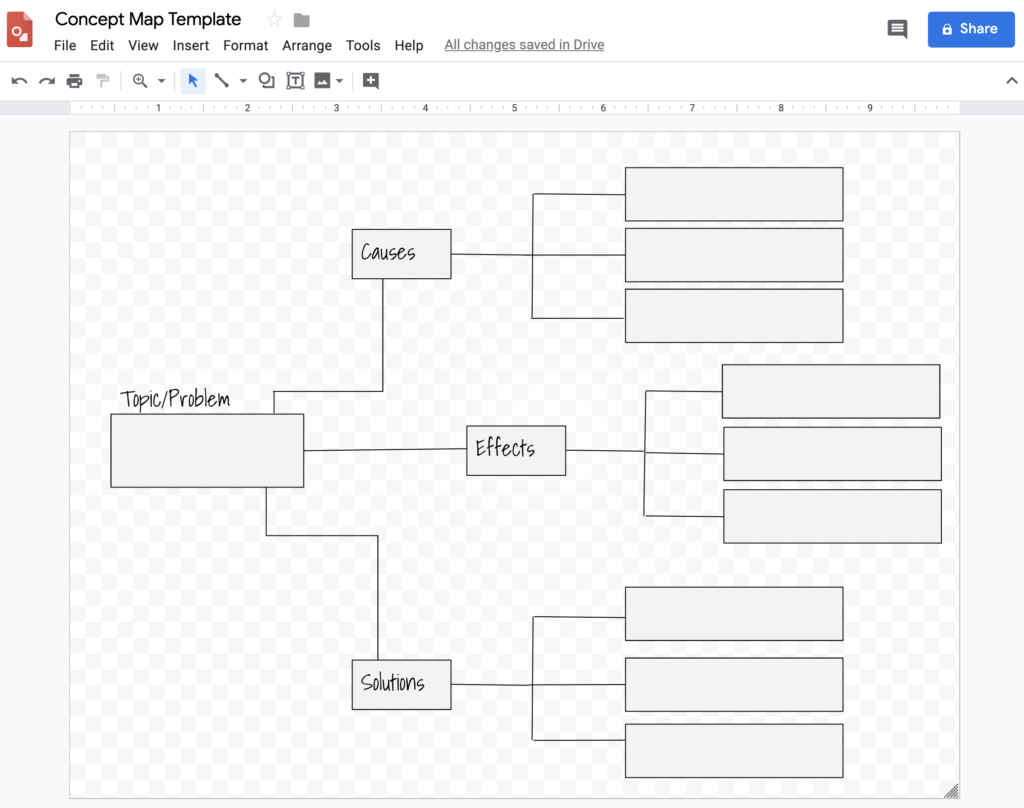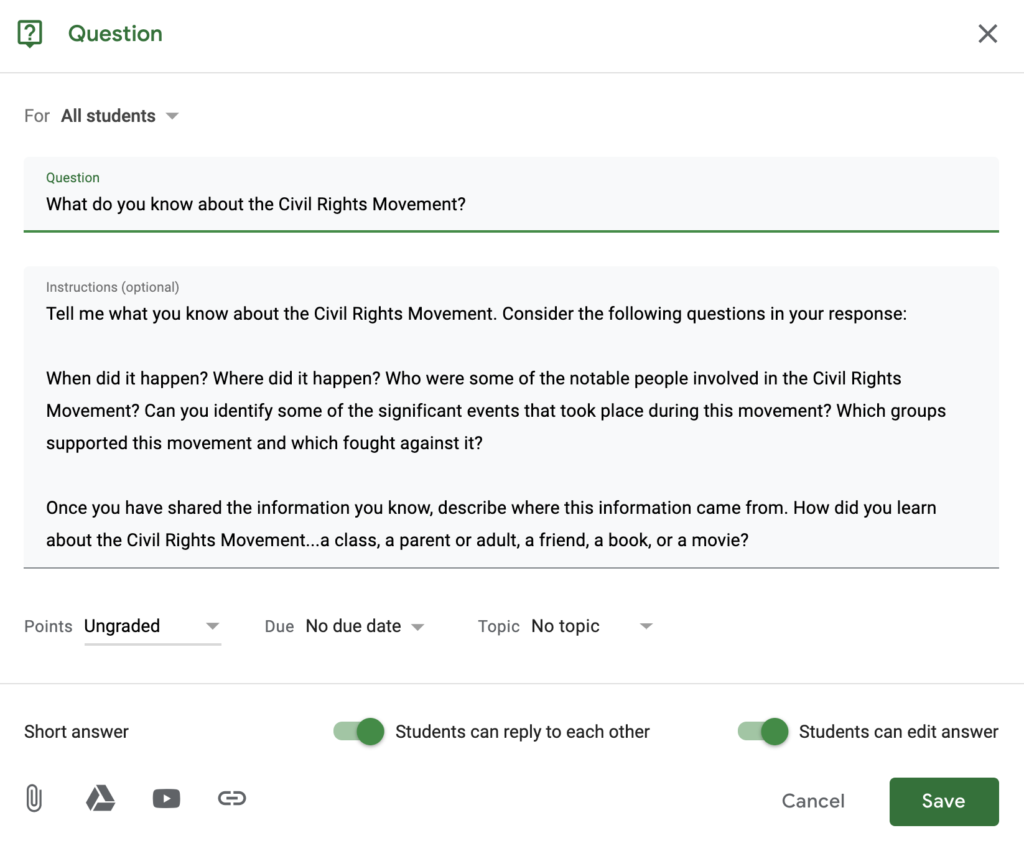Designing a one-size-fits-all lesson assumes that every student is starting from the same point. The reality is that students enter our classrooms with varied skillsets and prior knowledge. If teachers assess their students’ knowledge before diving into an explanation, lesson, or unit, they might be surprised by the wealth of experience and information that students bring into the classroom.

I had the pleasure of working with teachers in Texas this week. During the workshop, we explored strategies designed to assess prior knowledge (pre-lesson), check for understanding (during the lesson), and encourage students to reflect on their learning (post-lesson). I realized I had not written a blog about these strategies. I am dedicating the next three blog posts to discussing strategies teachers can use to collect informal data before, during, and after a lesson. The more teachers build mechanisms into their lessons to collect data, the more likely they are to adjust their lessons for learners at different levels.
Below are strategies I have used to gauge what students know prior to a lesson or unit. For any of these strategies to be effective, students must feel safe taking risks. Even though they may have some previous knowledge, they may not feel confident that they are “right.” I explain that these strategies will help me to understand what they know about a topic, so I can tailor the lesson or unit to their needs. Students need to know that they will not be graded or judged based on the accuracy of their answers.
1. Concept Map
Give students a concept map with a topic, problem, historical event, or person’s name. Then ask them to fill in as much information as possible using the structure of a concept map, like the one pictured below. Alternatively, students can create a free form concept map linking key ideas and information to a central topic.

2. Online Discussion
Unlike a class discussion in which only a handful of students get the opportunity to share their ideas, online discussions give everyone a voice. You can post a discussion question online using Google Classroom or Schoology and give students 5-10 minutes to describe what they know about a topic, concept, problem, historical event, or famous person. Ask them to describe where they learned this information–a conversation with a parent, a book or movie, another class, or from life experience.

3. Carousel Brainstorm
Put posters with a word, concept, or problem in each of the four corners of the room. As students move around the room, the goal is to add their thoughts, ideas, and prior knowledge to the posters. If you use big pieces of poster paper, students can write the information directly on the poster. Alternatively, you can print the topics on computer paper and ask students to write information on post-it notes and stick them on the wall.
If you post math problems around the room, ask students to explain how they think they might solve each problem. What strategies would they use? Why?

4. Three Things…Word Association
Ask students to share the first three words that come to mind when they hear a topic, concept, problem, historical event, or famous person’s name. Asking students to share the first three words they associate with a topic can reveal a lot about what information or misconceptions they are bringing into the learning environment.
You can have them share these words offline with post-its or post them online using Mentimeter. Mentimeter will transform their responses into a real-time word cloud. Words that are entered by multiple students will appear larger in the cloud amplifying the common associations that students are making. Teachers using Mentimeter cannot view individual student’s contributions to the word cloud, so this activity works better to read the room in terms of prior knowledge.

5. Two Minute Talks
Pair students up and ask them to spend a minute each describing what they believe they know about a topic. Encourage them to explain where they learned that information. During these quick chats, you can circulate around the room observing and listening. It amazes me how much I learn by simply watching students and listening to their conversations. In just a couple of minutes, I get a clear sense of who has prior knowledge on a topic and who does not.

6. 90 Second Brain Dump
Teachers who enjoy quick writes can give students 90 seconds to write everything they know about a topic. I use a Google Form for these quick brain dumps so that the students’ responses are shuttled to a Google Sheet. That makes it easy to skim their responses or use Control+F to search for keywords to see how frequently they occur in the sheet. This provides insight into what the class knows about this topic, but I can also look at individual responses to gauge a specific student’s knowledge of the subject.

If you have a strategy you use for assessing prior knowledge, please post a comment and share it! I love hearing what works well for other educators.

21 Responses
Thanks Catlin… these are great. For the two minute talk, I’ll often use an inner and outer circle where the students are facing each other just because I’m trying to have students up and moving whenever possible. I find adding some movement helps them stay focused. The outer circle rotates so I’ll say, “Outer circle, rotate 3 people.” The students never know how many people I’m going to get them to move and I love that they have random pairings.
For a topic like, “What do you remember about _____ or what words do you associate with _____” I have big white boards that fit over a group table. Students in each group each choose a different colour of marker, write their name in the top corner (so I know the contribution of each person) and then they talk and write their ideas. I ask that they try to go around so that everyone gets at least one idea recorded (I don’t want one person just blasting out 20 ideas). They can also help each other. Sometimes students know a lot more than even they think, but they need to piggyback off the ideas of others. THEN, when the group thinks they’ve exhausted their ideas, they do a quick walk to look at other groups. When they get back to their table, in yet ANOTHER colour, they add the ideas they didn’t have. They then take a photo of their board and upload it to our classroom. It’s a quick and relaxed way for me to learn who in the group remembers a lot (I circulate while they’re talking and listen) and the words/ideas that are identified by a lot of groups as not included initially are almost always what needs to be reviewed.
Thank you, Janice!
I agree that movement is positive for kids! I love any excuse to get kids out of their seats to move around 🙂
I appreciate you taking the time to share this strategy!
Catlin
There are manytrategies but commonly we use I see, I think, I wonder ; I know, I want to know; How it looks like, feels like and sounds like; What , Why and how, to assess their prior understanding of the concepts
There are many strategies but commonly we use I see, I think, I wonder ; I know, I want to know; How it looks like, feels like and sounds like; What , Why and how, to assess their prior understanding of the concepts
I like the idea behind the assessment routine of prior knowledge. Thumps up!
I love your 90-second brain dump! It fills the need of students who have a lot to share and takes the pressure off of students who might not have a lot to share.
Thanks for these. I often use the inside/outside circle. I also will sometimes post sentence starters around the room and have students complete the sentence with their prior knowledge. For example: the Civil Rights movement started in…; One of the key leaders of the Civil Rights Movement was… and so.on. Sometimes I will put the topic on the whiteboard and give the students 5 or so minutes to add what they know. Then we debrief together. There are many tools that can be used to immediately see students prior knowledge like Kahoot or Pear Deck.
Great ways to find out what funds of knowledge students bring and identify gaps and misconceptions in order to guide instruction. Thanks for sharing!
Great strategy
I like the different ways/suggestions to find out what the students know.
great suggestions!
I love the idea. I think, that using prior knowledge, is very important, because it tells you, how much they know about what they about the subject.
great response!
I love the 2 minute talk idea, it gives the kids a chance to socialize while learn and gives the teacher an idea of where everyone is at on the lesson they’re about to get into.
I also like the idea. Prior knowledge acts as an anchor for students to spring out into new and enhanced learning.
Is there a book available to go with this?
Great ideas.
Hi Margaret,
I address formative assessment in my blended learning book because it is key to differentiating effectively, but I do not have a book specifically on formative assessment with strategies you can use to do it effectively. You might enjoy the resources I created below though!
[Resource] Formative Assessment–Assessing Prior Knowledge Strategies
Take care.
Catlin
There are many strategies but commonly we use.
I use some of the same strategies, but in different unique ways in my math classes. The other ideas presented are awesome and let the students become active learners.
Asset-based teaching has roots in ‘funds of knowledge. This philosophy values the positives and strengths that students bring into the classroom. Asset-based teaching approaches each student as a whole person, including their culture, home life, prior experiences, and knowledge, with the perspective that all of these areas can be brought into the classroom environment. Boiled down to the nuts and bolts, asset-based teaching is about focusing on students’ strengths and building learning around those strengths and their existing knowledge instead of highlighting any deficits or cognitive gaps.
I use some of the same strategies but in different way in my biology class.